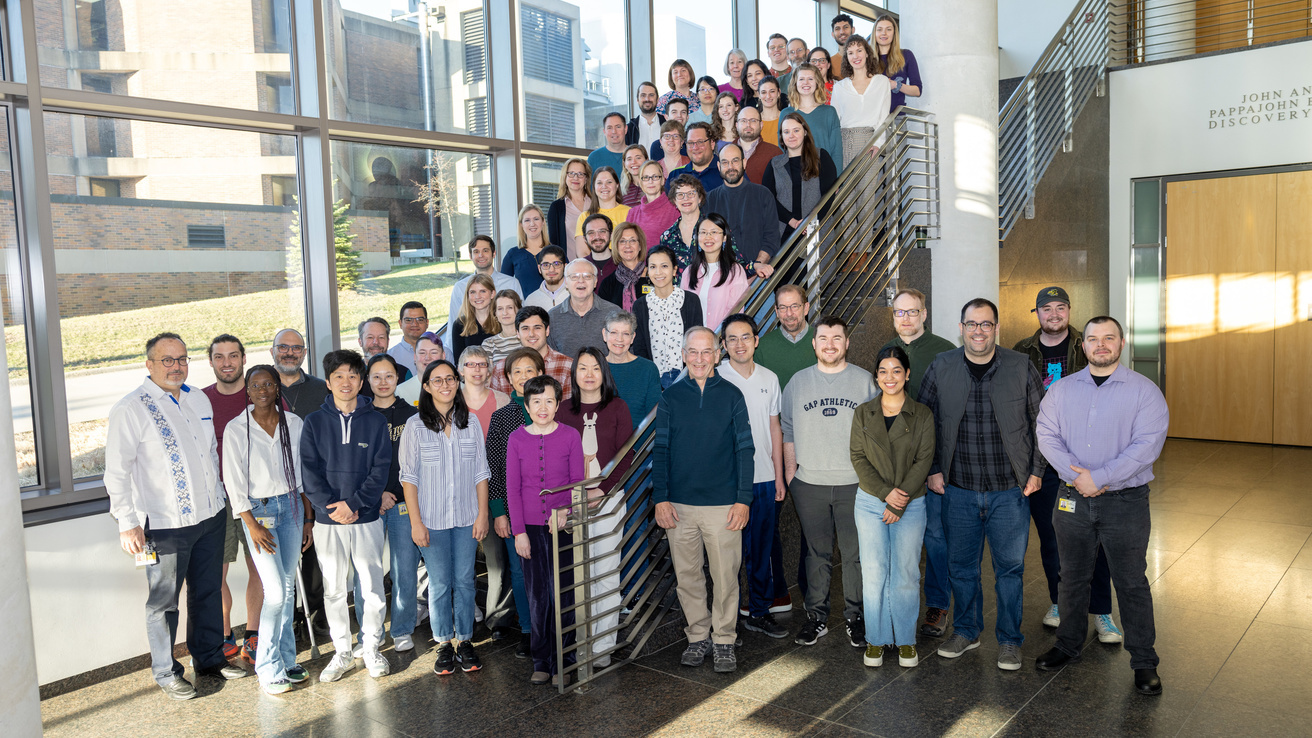
Lung Biology and Cystic Fibrosis Research Center
Founded in the fall of 2014, the PBI includes investigators focused on five thematic areas. PBI members hold academic appointments in departments across the university, and many conduct their research in the hub of the PBI, the Pappajohn Biomedical Discovery Building (PBDB). In the PBDB, we have removed as many walls as possible—both literal and figurative—to enable our scientists, engineers, physicians and trainees to see and hear and learn from each other on a daily basis. We work hard to reduce barriers between scientific and technological specialties and enable scientists to work across disciplines. We embrace biological problems in all their complexity and tackle some of the most intractable medical problems. Our gathering spaces, including our coffee shop, buzz with ideas and strategies for investigation. This environment catalyzes discovery and innovation.

Biomedical Sustainability Initiative
We are a growing group of University of Iowa scientists seeking to improve biomedical research sustainability practices in UI campus laboratories. Our focus areas include lab waste management, efficient energy usage, and promoting optimal environmental lab practices.

Welsh Lab
The Welsh laboratory emphasizes research in two main areas.
The first focuses on cystic fibrosis (CF), a common lethal genetic disease in which lung disease is the major cause of morbidity and mortality. Welsh and his colleagues are discovering the pathogenesis of airway disease and developing novel treatments.
The second focuses on neurodegenerative diseases, including Parkinson's disease and Alzheimer's disease. Welsh and his colleagues are investigating the pathophysiological basis of protein aggregates and developing treatments to prevent or delay the progressive neuron loss.

Pulmonary Microfluidic Laboratory
Chronic and infectious pulmonary diseases are profoundly impacting our society. In the pulmonary microfluidic lab, we integrate micro-engineering methods with biology to understand airway physiology, treat pulmonary disease, and eventually improve human health.

Alejandro Pezzulo, MD

Michael E. Duffy, PhD
Research in my laboratory concerns neurotransmitter and hormone-mediated anion (Cl- and HCO3-) secretion in the gastrointestinal system and airway, especially by the epithelium of the intestine and airway and by liver and pancreatic ducts. Of special interest are K+ channels in the basolateral cell membrane of these secretory cells that play a critical role in secretion by maintaining membrane potential as a driving force for anion exit across the apical cell membrane. We use electrophysiological techniques, like transepithelial voltage-clamp and whole-cell and single channel patch-clamp techniques, to characterize membrane ion channels. We also use intracellular fluorescence techniques (e.g., Fura-2) to determine the mechanisms by which neurotransmitters and hormones regulate ion channels via signal transduction pathways. Results of our studies will lead to understanding of normal anion secretion and will help develop remedies for defects in secretion, especially in diseases like secretory diarrhea and cystic fibrosis.

McCray Lab
Paul McCray, MD, is a pediatric pulmonologist with interests in airway innate immunity, epithelial cell biology, and the applications of genetic therapies for lung diseases.
Genetic therapies for the treatment of inherited diseases
The laboratory is using viral and non-viral vectors for gene addition and gene editing applications in airway epithelia. Our disease interests include cystic fibrosis, primary ciliary dyskinesia, and ABCA3 deficiency, problems that affect the pediatric population. A focus is on improving the efficiency of delivery of genetic therapy cargoes to respiratory epithelial cell types. We have developed novel lentiviral vector pseudotypes that target receptors on the apical surface of airway epithelia. Gene addition or repair in airway progenitor cell types could provide long lasting correction. A long-term goal is to develop vector systems with that can be successfully used in children to treat or prevent lung disease.
Pulmonary Host Defense
Despite the intimate contact between the lung and the external environment that occurs with each breath, the intrapulmonary airways are normally free of infection and inflammation. A well-orchestrated mucosal immune system contributes to this remarkable state of affairs. We are interested in host-pathogen interactions, defense mechanisms, and epithelial responses to bacteria and viruses. We are investigating how respiratory viral infections may contribute to the onset and progression of lung disease. Our interests include the interactions between airway epithelia and specific pathogens (RSV, influenza, PIV, SARS, MERS, SARS-2 coronaviruses, others).

Sinn Lab
The unifying goal of the Sinn Lab is to explore mechanisms of viral entry in the lungs for disease prevention or gene therapy applications.
Gene therapy for cystic fibrosis (CF) using integrating vectors
The lungs have evolved many barriers to keep foreign DNA out of its cells. Our goal is to override these barriers and get therapeutic genes into the lungs. CF is a common genetic multi-organ system disorder, but most people with CF die of progressive lung disease. We know that delivering the CFTR gene to enough airway cells will correct CF lung disease...
Engineering novel gene delivery tools
The aim of gene therapy vector development for life-long genetic diseases such as CF is to create a vehicle with the ability to efficiently, safely, and persistently express a transgene in the appropriate cell types. There are multiple viral based vectors for delivering genes to the airways. Each system has its pros and cons. Non-viral vectors, such as DNA transposons provide an expanded tool-set for gene transfer to cells....
Measles virus (MV) entry and spread in airway cells
Despite an effective vaccine, MV remains a world wide health burden and is resurging in the US. Medical texts teach that MV initially infects and replicates locally in respiratory cells and subsequently spreads to the lymphatic system. However, we challenged this dogma. Prior to our study in 2002, MV was thought to enter the apical surface of airway epithelia....
The University of Iowa Viral Vector Core
www.medicine.uiowa.edu/vectorcore
Dr. Sinn is the director of the Viral Vector Core at the University of Iowa. The core serves investigators world-wide and produces viral vectors for studies in the lung, eye, brain, liver, heart, muscle, cardiovascular, and neuromuscular systems. As such, the Viral Vector Core staff members are active participants in the development of gene transfer technologies in the cancer, neurobiology, cardiovascular, macular degeneration, and cystic fibrosis centers...

Stoltz Lab
The Stoltz lab focuses on the pathogenesis of cystic fibrosis related airway disease with a particular emphasis on studying airway epithelial and smooth muscle cells, the role of paraoxonases (PONs) on Pseudomonas aeruginosa quorum-sensing regulation, mucociliary clearance, and advanced airway imaging modalities and analysis.

Zabner Lab
The Zabner Lab is focused on gene transfer to human airway epithelia, in particular developing gene therapy for cystic fibrosis. Dr. Zabner also has an interest in the fluid composition of the airway surface liquid, and how it affects innate immunity. His clinical interests are in cystic fibrosis and non-cystic fibrosis bronchiectasis.
